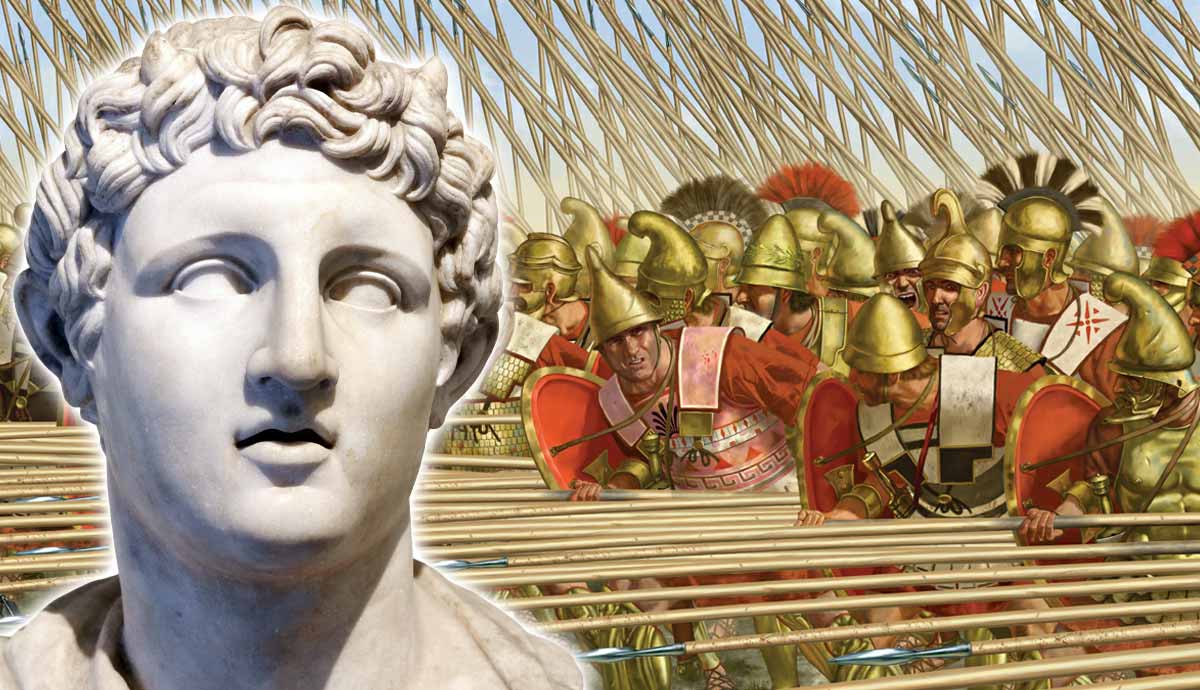
Mithridates VI Eupator (135-63 BCE) transformed Pontus from a small kingdom on the southern shore of the Black Sea into the last great Hellenistic state. Resourceful, ruthless and resilient, Mithridates’ empire covered most of modern Turkey, the Caucasus, and Crimea, challenging Roman supremacy for four decades. Only a succession of Rome’s most famous generals managed to end this resistance. Skillfully exploiting Roman divisions at a time of civil war, Mithridates almost reversed a century of seemingly inevitable expansion. In the process, the Pontic King became Rome’s principal foreign enemy and a subject of legends.
The Kingdom of Pontus and the Legends of Mithridates

Mithridates was born around 135 BCE into a Hellenistic world which had gone through a century of Roman expansion. The three great empires which had dominated the eastern Mediterranean, the Seleucids, Antigonid Macedonia, and Ptolemaic Egypt, were either in decline or had been defeated.
The Romans already held most of Asia Minor and Anatolia (modern Turkey) but the decline of the Seleucids had created space in the region for a number of states to grow. Bithynia, Cappadocia, Armenia and Galatia had all risen in importance in the 2nd century BCE. To the north of these regions and along the southern shore of the Black Sea was Pontus. With a coast dotted with Greek cities and a mountainous interior, Pontus was a varied and rich region. For more than a century a society formed from Greek, Persian and Anatolian cultural influences was ruled over by the Mithridatic dynasty which claimed descent from the royal family of the old Persian Empire.

Pontus rarely made it into our surviving historical record in the 3rd and 2nd centuries BCE. There are references to the rulers of Pontus siding with various Seleucid monarchs and eventually with the Romans but the region did not play a significant role until the reign of Mithridates VI. His transformation of the region into a state capable of challenging Rome was then a significant achievement.
Not surprisingly for a figure who became a nemesis of the Romans, many legends attached themselves to Mithridates. Alongside a ruthless streak which saw him oversee the deaths of thousands including his own family, he became especially associated with poison. In his dangerous and difficult early years before he was firmly established as ruler of Pontus, Mithridates was believed to have escaped his rivals by taking to the wilderness and learning its myriad languages and seeking to protect himself by building an immunity to poison. He gradually built up this immunity by slowly exposing himself to small doses. This practice is still referred to as Mithridatism.
Challenging Rome: The Mithridatic Empire at its Height

Mithridates’ rise to the throne of Pontus in 113 BCE was far from straightforward, involving as it did the death of his mother and a brother. The first decades of Mithridates’ long reign he gained control or influence over much of Anatolia, the Caucasus, and the Crimea, building a vast and wealthy Pontic Empire. Expansion north, south, and east avoided direct confrontation with the Roman presence to Pontus’ west.
Mithridates’ father had benefited from an alliance with Rome but the territories Pontus gained were later removed. Once in control of a rich and populous empire, Mithridates no doubt understood the danger Rome posed to its continuation. On the other side, the Romans generally took little prompting to break up any threat to their own dominance.
The decades-long war between Mithridates and the Romans started when the latter attempted to curtail the Pontic king’s growing empire. In the late 90s BCE a proxy war over Cappadocia and Bithynia turned into a direct confrontation between Rome and Mithridates. The Romans may have underestimated Mithridates or perhaps did not intend to begin a full-scale war as their commander, Manius Aquilius, largely relied on Bithynians and Cappadocians to fight his battles. The result was a disaster for the Romans as by 89 BCE Mithridates’ generals had overrun Bithynia, Cappadocia, and the Roman province of Asia, capturing Manius in the process.

In just a few years the Pontic armies had reversed Roman expansion in the region. Mithridates now moved brutally against the remaining Roman presence. The region had not had a warm introduction to the Roman Empire. Romans and Italians made themselves hated as tax collectors and extortionate money lenders. Mithridates used this hatred to consolidate his position. Orders were sent out across the newly won empire for a coordinated massacre of Romans and Italians known as the Asian Vespers. Many in the cities and territories across Asia Minor were willing to turn on the Romans, leaving anywhere between 50,000 and 150,000 dead.
This attempt to eradicate the Roman presence moved the war onto another level. In Rome, one of its greatest generals, Lucius Cornelius Sulla, was appointed to take command. Serious as the war now was, the Romans were distracted by events closer to home. The 1st century BCE was one of Rome’s most turbulent periods. Civil and foreign wars, slave revolts, piracy, and political polarization distracted and divided the Romans giving Mithridates hope and opportunities he skillfully exploited.
With Sulla held up marching on Rome itself, Mithridates advanced further, crossed the Aegean to Greece, and brought the war to Europe. The recently conquered Greeks wavered in their loyalty to Rome and Athens welcomed a Pontic army under the general Archelaus. When Sulla finally arrived, it took a determined siege of Athens and its port Piraeus from 87-86 BCE to break this alliance. Weakened by starvation, Athens was eventually stormed by Sulla’s army, leading to a massacre and sack of the renowned city.
Despite this setback Mithridates committed to this expedition in Greece and provided Archelaus with an army which, according to our sources, numbered 120,000 to Sulla’s 30,000. The outnumbered Romans crushed this army at the Battle of Chaeronea in 86 BCE. When Mithridates sent out another large army as reinforcements, Sulla defeated this as well a little to the north at Orchomenus.
With Mithridates’ brief Greek empire over, his Asian empire was in danger. At this stage, Roman divisions came to Mithridates’ aid. In his absence, Sulla had been declared a public enemy and a rival Roman army headed east. These divisions prevented the Romans from crushing Mithridates. Seizing the opportunity, Mithridates proposed peace to Sulla which the Roman general accepted. Mithridates had to give up most of his recently acquired territories, provide ships to Sulla, and pay an indemnity, but he had peace with the most powerful man in Rome.
Recovery and War With Lucullus

Mithridates’ generals were capable of defeating Roman forces but were no match for a well-led Roman army when they confronted Sulla in Greece. Much the same pattern repeated itself in the next phase of the war, although Mithridates learned from previous encounters. Our sources in Appian and Plutarch disagree on the timing but state that Mithridates tried to copy the Roman legions that defeated him and equipped his armies in the Roman fashion. Little subsequent detail is given but the attempt marks Mithridates out as capable of learning from his enemies.
Whether his army was successfully reformed or not, Mithridates was soon in need of it again. After Sulla’s departure, another commander, Murena, started a brief second Mithridatic War on his own initiative in 83 BCE. This attempt was defeated the following year after Murena invaded Pontus. An interlude of several years allowed Mithridates to consolidate his empire in the east before one of Sulla’s former deputies, Lucius Licinius Lucullus, arrived in 74 BCE to begin the next phase of the war.

The decisive battle of this third Mithridatic War came when Mithridates attempted to reconquer Bithynia and take the city of Cyzicus. Mithridates heavily outnumbered his Roman opponent with an army of more than 140,000. Unlike previous campaigns, Mithridates himself took command and placed Cyzicus under siege. He was, however, outmaneuvered by Lucullus who seized control of the surrounding mountains and cut off his supplies. With the citizens of Cyzicus resisting and his army isolated, the siege turned into a disaster forcing Mithridates into a retreat which destroyed his army. Pontus itself was now vulnerable.
Mithridates tried to bring together another army but this was quickly dispersed. As much of Pontus fell into Lucullus’ hands, Mithridates fled to Armenia where his son-in-law, Tigranes, ruled and had built a successful kingdom in much the same manner as Mithridates. The two kings had cooperated in the past and Tigranes refused to surrender his father-in-law, but kept Mithridates at a distance. This refusal brought about a Roman invasion of Armenia. Tigranes and his army did not fare any better than Mithridates as Lucullus won a series of battles in 69 and 68 BCE.
Defeated and exiled, Mithridates was far from giving up and a combination of resilience and Roman divisions would once again see a remarkable return.
Return to Pontus and the Arrival of Pompey

Lucullus had marched further east than any previous Roman commander, defeating both Mithridates and Tigranes, but his soldiers were near mutiny. Many had been away from home for several years and probably believed their task was done. Opponents of Lucullus in Rome fed this discontent and accused him of continuing the war for his own benefit. As discontent in the Roman army grew, Mithridates returned to the unconquered regions of Pontus and raised another army.
With this new army Mithridates inflicted a heavy defeat on a Roman force killing many of its officers. Lucullus could still claim to be the conqueror of two countries but he would be denied credit for ending this long war. In 66 BCE, another of Rome’s most famous generals joined the war. Not for the first time in his career Gnaeus Pompeius Magnus, better known as Pompey, arrived to finish a war largely won by others.
As Pompey approached, Mithridates sued for peace but refused when Pompey demanded unconditional surrender. Mithridates hoped that Pompey’s advance would be hindered by a lack of supplies as he crossed an already devastated country. But Pompey’s skill as a general lay in his organizational capacities and his well-supplied army marched on. The remaining Pontic forces were defeated and Mithridates once again had to flee into exile. This time there would be no return to Pontus for him, but one more remarkable feat still lay ahead.
Mithridates and a few remaining followers fled towards the Caucasus. Pompey pursued but eventually turned south to conquer and reorganize much of the Middle East. There seemed little reason to follow an elderly man with few supporters deep into a wild and difficult country. So remote was this region for the Romans that they believed they were entering mythical territory as they passed through Colchis in the footsteps of Jason and the Argonauts and mistook female soldiers for Amazons. Few could have imagined they would hear from the fugitive again.
As the later Roman historian Appian put it, Mithridates still harbored ambitions beyond those of a fugitive. Heading north through the mountains he allied with some inhabitants and fought off others until he reached the remaining territories of the Pontic Empire under the control of his son, Machares, around the Crimea and Sea of Azov. After surviving this unlikely journey, Mithridates was not met with open arms. Machares had already made his peace with the Romans and Mithridates seizure of control resulted in his death. Once again Mithridates set about preparing a new army. Whilst building this new army Mithridates killed or caused the death of two of his sons and held suspicions of his heir, Pharnaces. This discord finally brought about Mithridates’ end.
The Death of Mithridates the Great

Rather than wait for his turn to be killed, Pharnaces revolted against his father in 63 BCE. When even the king’s bodyguard started to defect, Mithridates was left isolated with just two of his remaining daughters and a few guards.
Mithridates’ death became one final legend. With the end near and fearing being handed over to the Romans, he decided to end his life. Taking out one of the poisons he always carried, he gave some to his daughters who soon died. It did not work on Mithridates himself, however, as his attempts to become immune proved frustratingly successful. Only with the assistance of a guard was Mithridates able to commit suicide. Whether the details of the story are true or were a later ironic invention, we are unlikely to ever know for certain, but after a reign of 57 years, Mithridates’ long wars with Rome were finally over.
That Mithridates’ end came due to murderous disputes with his own family and involved the unnecessary deaths of two daughters testifies that his long life and reign were turbulent and destructive. Despite this, his Pontic Empire was the last great Hellenistic state and Mithridates came closer than anyone else to reversing Roman expansion. Following his death there was little remaining resistance to Rome in the Eastern Mediterranean.










